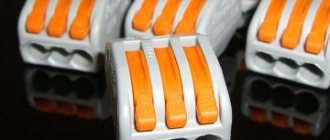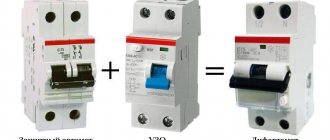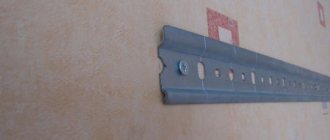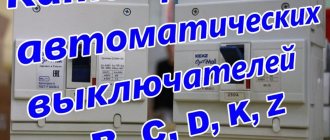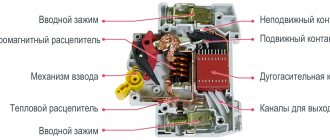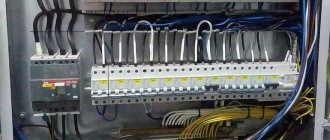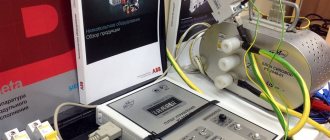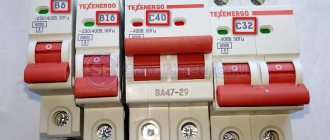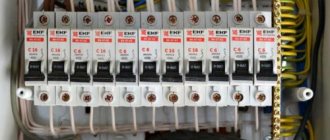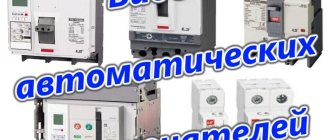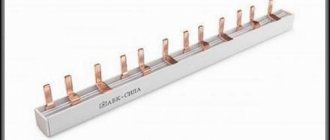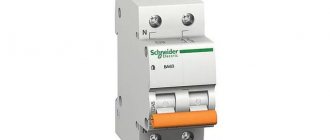Advantages and disadvantages
ABB is a Swedish-Swiss corporation founded in 1988 by the merger of the Swedish ASEA and the Swiss Brown, Boveri & Cie. She specializes in electrical engineering, energy and information technology. It is familiar to the average consumer from the circuit breakers with a red stripe on the front panel.
Advantages:
- Circuit breakers comply with the declared electrical parameters.
- Excellent quality materials.
- Good mechanics and assembly.
- Production is in European countries, Russia, a smaller part is produced in Asian countries.
- The assortment includes machines of different price categories, which will allow you to choose a high-quality product that matches your capabilities.
The main disadvantage of all ABB products is that there are a lot of fakes of dubious quality on the market. This is due to the popularity of the brand. Therefore, purchase equipment for electrical panels only from large retail outlets or dealer stores.
ABB's main competitor is Schneider Electric, so there are debates on forums about the pain of choosing between them; also, Legrand brand products may be an alternative.
Description of single-pole switches ABB SH201L C
Modular single-pole switches ABB SH201L C are designed to protect electrical circuits from overloads and short circuits in cable lines, electric motors, lighting systems, and socket lines. They have two different trip mechanisms: a delayed thermal trip mechanism for overload protection and an electromechanical trip mechanism for short circuit protection.
Circuit breaker device
The body material of the SH201L C is made from the most advanced materials, consisting of the latest generation of thermoplastics, which do not contain halogen pollutants and are recyclable.
All circuit breakers are equipped with contact position indication (CPI). You can easily determine whether the circuit breaker is in the on position, which makes maintenance work easier and safer.
Episode overview
There are three series of ABB circuit breakers that are used in home electrical panels:
- S200
- SH200l
- Basic M
Let's consider the technical characteristics and features of the circuit breakers of each series. But before moving on to the review, it is worth saying that all products can be one-, two-, three- and four-pole. Various configurations are possible, for example:
- bipolar, in which each pole has thermal and electromagnetic releases, it is marked as 2p;
- two-pole, in which there is a release in only one pole, it is marked as 1p+N, or the letters NA are added to the factory marking.
The same applies to three-phase circuit breakers. Marking is carried out as follows (possible options are listed):
1P, 1P+N, 2P, 3P, 3P+N and 4P
On the front panel, the differences between 1P+N and 2P using the example of ABB S202 C25 and C40 machines look like this (differences in the circuit):
S200
ABB S200 is the most “powerful” and advanced of the entire line and belongs to a series of products called System pro M compact. Let's start with the fact that the S200 series circuit breakers have a maximum short-circuit current (breaking capacity) of up to 25,000 amperes (25 kA). This means that power contacts are capable of disconnecting a circuit in which a current of the specified magnitude briefly flows without being destroyed.
ABB circuit breakers from the System pro M compact family are available in three types: S200, S200 M and S200 P. They differ in breaking capacity of 6kA (most common), 10kA and 25kA.
Range of rated currents of circuit breakers of this series:
0.5, 1, 1.6, 2, 3, 4, 6, 10, 16, 20, 25, 32, 40, 50, 63, 80, 100
Products are produced with time-current characteristics of all known types:
B, C, D, K and Z
The next feature is the ability to connect a PIN rail to connectors specially designed for it. If you do not use such rails in your installation, you can connect an additional wire instead, so as not to squeeze several wires into one terminal block. The design allows clamping of cores with a cross-section of up to 35 square meters. mm in machines with a rated current of up to 63A, and 50 sq. mm for 80 and 100 amp models.
The use of PIN rails not only makes installation neat and reliable, but also saves space in the electrical panel (in some cases this is critical). On the front automatic panel there is a window with a status indication.
SH200l
The next series in our review is SH200l. This is a slightly simplified version; it belongs to the Compact Home product family; its main external difference from the S200 is the different terminal blocks. They are not square, but semicircular.
Thanks to this, the contact contact area is larger, and the crimping is better when connecting several conductors. The manufacturer's catalog states that the maximum cross-section of connected conductors is up to 25 square meters. mm. There is no power indicator on the front panel of ABB SH200L machines
The second significant difference from the S200 circuit breakers is the lower breaking capacity - 4.5 kA, but for most cases this is more than enough (especially for domestic use). Available with tripping characteristics B and C, and a range of rated currents from 6 to 63 A, with a standard step:
6, 10, 16, 20, 25, 32, 40, 50, 63
Basic M
The third in our review will be the ABB Basic M series of automatic machines - it is slightly different in appearance from the previous two, but in terms of characteristics it is almost similar to the SH200l. If the S200 and SH200L are produced in Germany, then the Basic M is produced in Bulgaria.
ABB Basic M series circuit breakers are characterized by a breaking capacity of 4.5 kA, and a range of rated currents from 6 to 63 A with response characteristic C. In the model with a rated current of 6 to 40 amperes, conductors with a cross-section of up to 25 sq. m can be connected. mm, and in 50-63 ampere circuit breakers - up to 35 sq. mm.
Based on user reviews, we can say that in terms of manufacturing quality and ease of installation, ABB Basic M circuit breakers are not inferior to their “big brothers”, although they are cheaper.
PIN rails
An integral part of modern, beautiful and reliable installation is the use of PIN rails, or as electricians call them “combs” or “combs”. These slats are used to connect the machines in the panel. ABB has three series of PIN rails:
- PS – designed for connecting equipment for the S series panel.
- PSH – intended for the SH series.
- Basic M.
They are quite different; if you use the PSH rail with S200 assault rifles, you will have to turn it in the opposite direction, that is, with the plastic protection facing you. Otherwise, it will not be installed level and you will not be able to connect the cable.
The rails are produced with a different number of poles, which allows you to organize the installation of a three-phase switchboard or connect an RCD or other two-pole devices. The number of poles of the rail is indicated by the first number after the marking: PS1 is single-pole, and PS2 is two-pole, the following numbers are the number of modules that you can connect. In this case, the poles alternate: 1-2-3-1-2-3, in the example of a three-pole bus you can see this below, the pole marking is circled in red.
There are also special tires for Basic M, you can see them below, they are similar to PSH.
Selecting a circuit breaker
The choice of switches is mainly carried out according to the load power and the cross-section of the connected wire, taking into account 2 parameters: overload current and short-circuit shutdown current.
Current overload occurs when devices and devices are connected to the network, the total power of which will lead to excessive heating of conductors and contact connections. Therefore, the machine that will be installed in a specific circuit must have a shutdown current greater than the so-called reserve or equal to the calculated one. It is determined by summing the power of the electrical devices intended for use, which is often indicated in the passport. Next, the resulting figure is divided by 220 and our overload current is obtained. One more important circumstance should also be taken into account: this current should not be greater than the current that can flow through the conductor.
The shutdown current during a short circuit is the value at which the circuit breaker turns off; it is also called cutoff. It is also calculated and then selected according to the type of protection. The type of protection contains the values of the shutdown current in relation to the probable short-circuit current, depending on the type of load in the electrical network. In everyday life and for small objects, devices are used with the symbol characteristics B, C, and at the input - D. Most often, in addition to the circuit breakers for each group line, the electrical circuit also includes an input circuit breaker, an RCD or a differential circuit. machine.
Marking of SH201L C machines
The body of the SH201L C 1P series circuit breakers contains all the necessary markings, such as:
- - manufacturer;
- — model;
- — rated current and type of response characteristic;
- — operating voltage of the network;
- — breaking capacity;
- — current limitation class;
- — schematic diagram of the switch operation.
ABB circuit breakers comply with IEC/EN 60898-1 and IEC/EN 60947-2 standards and carry all relevant certification marks for each market and segment for which they are designed. Certification marks are also printed on the circuit breaker body. For the inspection and acceptance procedure, certification marks are clearly visible on the body. All markings are made using laser printing technology, which is resistant to abrasion and solvents, which ensures a long service life and ease of product identification.
Rated current table SH201L C 1P/ SH201L C+ NA
| Number of poles | Rated current | Number of modules | Series | Manufacturer's code |
| In A | 17.5 mm | |||
| 1P | 6 | 1 | SH201L C6 | 2CDS241001R0064 |
| 1P | 8 | 1 | SH201L C8 | 2CDS241001R0084 |
| 1P | 10 | 1 | SH201L C10 | 2CDS241001R0104 |
| 1P | 13 | 1 | SH201L C13 | 2CDS241001R0134 |
| 1P | 16 | 1 | SH201L C16 | 2CDS241001R0164 |
| 1P | 20 | 1 | SH201L C20 | 2CDS241001R0204 |
| 1P | 25 | 1 | SH201L C25 | 2CDS241001R0254 |
| 1P | 32 | 1 | SH201L C32 | 2CDS241001R0324 |
| 1P | 40 | 1 | SH201L C40 | 2CDS241001R0404 |
| 1P | 50 | 1 | SH201L C50 | 2CDS241001R0504 |
| 1P | 63 | 1 | SH201L C63 | 2CDS241001R0634 |
| 1P | 6 | 1 | SH201L C6 NA | 2CDS241103R0064 |
| 1P | 8 | 1 | SH201L C8 NA | 2CDS241103R0084 |
| 1P | 10 | 1 | SH201L C10NA | 2CDS241103R0104 |
| 1P | 13 | 1 | SH201L C13NA | 2CDS241103R0134 |
| 1P | 16 | 1 | SH201L C16NA | 2CDS241103R0164 |
| 1P | 20 | 1 | SH201L C20NA | 2CDS241103R0204 |
| 1P | 25 | 1 | SH201L C25NA | 2CDS241103R0254 |
| 1P | 32 | 1 | SH201L C32NA | 2CDS241103R0324 |
| 1P | 40 | 1 | SH201L C40NA | 2CDS241103R0404 |
Application of single-pole circuit breakers SH201L C
Modular circuit breakers of the SH201L C series, as a rule, have all possible designs according to the operating characteristics of circuit breakers, which indicates their wide application segment. They are usually used for surge protection by installing on a DIN rail in distribution boards, boxes located in residential buildings, offices, warehouses, and other industrial and commercial premises. SH201L C is used to protect circuits with active and inductive loads and low pulse current (providing electricity to apartments, offices, industrial facilities).
